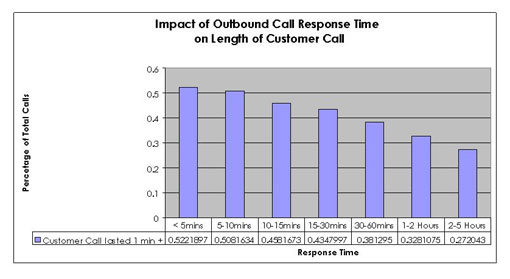The fact remains that, no matter how much you spend on website design and content, people get stuck.
If you can identify these prospects and speak to them instantly, you’ve got the opportunity to help them through the process, answer their questions and, most importantly, close the sale. And this is where outbound calling comes in. Shopping cart abandonment is a real problem for online retailers, with statistics indicating that 60 per cent of online shoppers give up before completing their transaction. There are a number of reasons for this. Perhaps the person didn’t know what they needed to put in Box A, or were not sure whether your product does this or that. Other common factors include that customers could not contact customer support or they forgot their username and password.
You need to speak to them within 15 minutes
To demonstrate the importance of making calls to the customer quickly, we did some analysis on calls made by some of our clients to their prospects. We took a sample of 28,000 car insurance calls made between March and May 2009.
We looked at the response time i.e. the elapsed time from the customer completing the quote to when they were called, and then the length of each of those calls.

The length of the customer call gives us a good proxy for both Decision Maker Contact (DMC) and conversion. Where the customer call has been answered and has lasted at least 1 minute we can assume that this was a solid DMC. At the left end of the graph you can see that 52% of customer calls lasted at least 1 minute, when the call was made within 5 minutes.
After 2 hours this figure reduced to 27%, i.e. your chance of getting a Decision Maker almost halves after a 2-hour delay.
Customer concerns
Warn the customer that you will call
One of the common concerns is that the customer will find the call intrusive. Some important points to note on this are, firstly, that the leads are already warm. Only customers that have willingly provided their correct telephone number as part of the online process are called.
Secondly, if I’m a customer who is researching or trying to buy your product and I’ve given you my phone number, I might be a bit surprised or impressed at how efficient you are to call me back and I don’t really have any grounds to complain. If the call results in me getting what I want then actually, I’m pretty happy.
Fast call back = more receptive customer
Finally, the fact that you have called me instantly means that I’m more likely to still be receptive, i.e. I’ve got time to talk to you and actually, I do have a couple of questions. If you call a few hours or even days later, your call is much more likely to be a nuisance rather than a help.
The feedback that we get from our clients is that the customer response is generally very positive with more people impressed at the service than annoyed.
Top Ten Tips
1. Make sure you capture the customer’s contact details and permissions as early in your online process as possible. Until you know who they are, they’re not a lead and the sooner you capture that information the more leads you’ll have.
2. Have a process in place that allows you to call the prospect within 15 minutes.
3. Make sure that the staff making the calls are properly briefed and understand what you are doing, why, what the objectives are and exactly what they need to do.
4. Most importantly, make sure that you get sales staff to make the calls and not the customer service staff, as it doesn’t work.
5. Set your staff targets and make sure that you have enough data to performance manage them.
6. Use ‘call blending’ as much as possible and use spare inbound capacity to make the outbound calls. As soon as there is an agent free they should immediately get an online lead to call. This does away with the staff overhead of having an outbound team and improves the efficiency of the inbound teams. We’ve found that inbound staff actually adapt to this type of outbound call really well, and some agents have moved from inbound to outbound and not wanted to go back because they were selling more.
7. Prioritise the leads that you are most likely to convert – by value, frequency of purchase, existing customers/new prospects, product type, etc.
8. Ensure that you have real-time management information to allow you to performance-manage your staff effectively.
9. Test different propositions on the call to see what works best and keep testing new things.
10. If you don’t have the resource do the outbound yourself you can always outsource it, but, of course, that adds cost.

Graham Mace
Graham Mace is the Director of Optilead (www.optilead.co.uk)
Author: Jo Robinson
Published On: 5th May 2010 - Last modified: 30th Jun 2017
Read more about - Technology, Customer Experience (CX), Customer Service, Outbound






















This is a very informative article. I really like your Top 10 Tips, expecially the idea of call blending. I work in sales and customer service training, and I wanted to share a thought on how the two can go hand-in-hand. Sure, some people are more sales-focused, but that doesn’t mean that they cannot be customer-focused as well.
Again, thank you for sharing such a great article!
Excellent post . Very informative